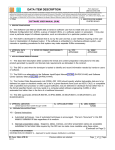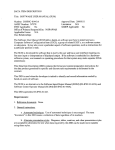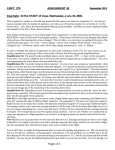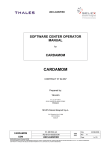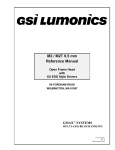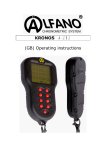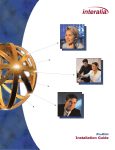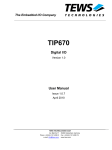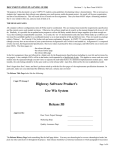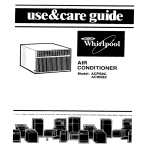Download DID DI-IPSC-81443, Software User Manual
Transcript
DATA ITEM DESCRIPTION Form Approved OMB NO.0704-0188 Public reporting burden for collection of this information is estimated to average 110 hours per response, including the time for reviewing instructions, searching existing data sources, gathering and maintaining the data needed and completing and reviewing the collection of information. Send comments regarding this burden estimate or any other aspect of this collection of information, including suggestions for reducing this burden to Washington Headquarters Services, Directorate of Operations and Reports, 1215 Jefferson Davis Highway, Suite 1204, Arlington, VA 22202-4302, and to the Office of Management and Budget, Paperwork Reduction Project (0704-0188), Washington , DC 20503. 1. TITLE 2. IDENTIFICATION NUMBER SOFTWARE USER MANUAL (SUM) DI-IPSC-81443 3. DESCRIPTION/PURPOSE 3.1 The Software User Manual (SUM) tells a hands-on software user how to install and use a Computer Software Configuration Item (CSCI), a group of related CSCIs, or a software system or subsystem. It may also cover a particular aspect of software operation, such as instructions for a particular position or task. 3.2 The SUM is developed for software that is run by the user and has a user interface requiring on-line user input or interpretation of displayed output. If the software is embedded in a hardware-software system, user manuals or operating procedures for that system may make separate SUMs unnecessary. 4. APPROVAL DATE (YYMMDD) 5. OFFICE OF PRIMARY RESPONSIBILITY 941205 EC 6a. DTIC APPLICABLE 6b. GIDEP APPLICABLE 7. APPLICATION/INTERRELATIONSHIP 7.1 This Data Item Description (DID) contains the format and content preparation instructions for the data product generated by specific and discrete task requirements as delineated in the contract. 7.2 This DID is used when the developer is tasked to identify and record information needed by hands-on users of software. 7.3 The SUM is an alternative to the Software Input/Output Manual (SIOM) (DI-IPSC-81445) and Software Center Operator Manual (SCOM) (DI-IPSC-81444). 7.4 The Contract Data Requirements List (CDRL) (DD 1423) should specify whether deliverable data are to be delivered on paper or electronic media; are to be in a given electronic form (such as ASCII, CALS, or compatible with a specified word processor or other support software); may be delivered in developer format rather than in the format specified herein; and may reside in a computer-aided software engineering (CASE) or other automated tool rather than in the form of a traditional document. 7.5 This DID supersedes DI-MCCR-80019A, DI-IPSC-80694, DI-MCCR-80313, DI-MCCR-80314, and DI-MCCR-80315. 8. APPROVAL LIMITATION Limited Approval from 12/5/94 through 12/5/96 9a. APPLICABLE FORMS 9b. AMSC NUMBER N7086 10. PREPARATION INSTRUCTIONS 10.1 General instructions. a. Automated techniques. Use of automated techniques is encouraged. The term "document" in this DID means a collection of data regardless of its medium. b. Alternate presentation styles. Diagrams, tables, matrices, and other presentation styles are acceptable substitutes for text when data required by this DID can be made more readable using these styles. (Continued on Page 2) 11. DISTRIBUTION STATEMENT DISTRIBUTION STATEMENT A. Approved for public release; distribution is unlimited. DD Form 1664, APR 89 135/123 Previous editions are obsolete Page 1 of 6 Pages Software User Manual (SUM) DI-IPSC-81443 10. PREPARATION INSTRUCTIONS -- 10.1 General Instructions (continued) c. Title page or identifier. The document shall include a title page containing, as applicable: document number; volume number; version/revision indicator; security markings or other restrictions on the handling of the document; date; document title; name, abbreviation, and any other identifier for the system, subsystem, or item to which the document applies; contract number; CDRL item number; organization for which the document has been prepared; name and address of the preparing organization; and distribution statement. For data in a database or other alternative form, this information shall be included on external and internal labels or by equivalent identification methods. d. Table of contents and index . The document shall contain a table of contents providing the number, title, and page number of each titled paragraph, figure, table, and appendix, and an index providing an alphabetic listing of key terms and concepts covered in the document and the pages or paragraphs in which the terms or concepts are covered. For data in a database or other alternative form, this information shall consist of an internal or external table of contents containing pointers to, or instructions for accessing, each paragraph, figure, table, and appendix or their equivalents. e. Page numbering/labeling. Each page shall contain a unique page number and display the document number, including version, volume, and date, as applicable. For data in a database or other alternative form, files, screens, or other entities shall be assigned names or numbers in such a way that desired data can be indexed and accessed. f. Response to tailoring instructions . If a paragraph is tailored out of this DID, the resulting document shall contain the corresponding paragraph number and title, followed by "This paragraph has been tailored out." For data in a database or other alternative form, this representation need occur only in the table of contents or equivalent. g. Multiple paragraphs and subparagraphs . Any section, paragraph, or subparagraph in this DID may be written as multiple paragraphs or subparagraphs to enhance readability. h. Standard data descriptions . If a data description required by this DID has been published in a standard data element dictionary specified in the contract, reference to an entry in that dictionary is preferred over including the description itself. i. Substitution of existing documents . Commercial or other existing documents may be substituted for all or part of the document if they contain the required data. 10.2 Content requirements. Content requirements begin on the following page. The numbers shown designate the paragraph numbers to be used in the document. Each such number is understood to have the prefix "10.2" within this DID. For example, the paragraph numbered 1.1 is understood to be paragraph 10.2.1.1 within this DID. Page 2 of 6 Software User Manual (SUM) DI-IPSC-81443 10. PREPARATION INSTRUCTIONS -- 10.2 Content Requirements (continued) 1. Scope. This section shall be divided into the following paragraphs. 1.1 Identification. This paragraph shall contain a full identification of the system and the software to which this document applies, including, as applicable, identification number(s), title(s), abbreviation(s), version number(s), and release number(s). 1.2 System overview. This paragraph shall briefly state the purpose of the system and the software to which this document applies. It shall describe the general nature of the system and software; summarize the history of system development, operation, and maintenance; identify the project sponsor, acquirer, user, developer, and support agencies; identify current and planned operating sites; and list other relevant documents. 1.3 Document overview. This paragraph shall summarize the purpose and contents of this manual and shall describe any security or privacy considerations associated with its use. 2. Referenced documents. This section shall list the number, title, revision, and date of all documents referenced in this manual. This section shall also identify the source for all documents not available through normal Government stocking activities. 3. Software summary. This section shall be divided into the following paragraphs. 3.1 Software application. This paragraph shall provide a brief description of the intended uses of the software. Capabilities, operating improve ments, and benefits expected from its use shall be described. 3.2 Software inventory. This paragraph shall identify all software files, including databases and data files, that must be installed for the software to operate. The identification shall include security and privacy considerations for each file and identification of the software necessary to continue or resume operation in case of an emergency. 3.3 Software environment. This paragraph shall identify the hardware, software, manual operations, and other resources needed for a user to install and run the software. Included, as applicable, shall be identification of: a. Computer equipment that must be present, including amount of memory needed, amount of auxiliary storage needed, and peripheral equipment such as printers and other input/output devices b. Communications equipment that must be present c. d. Other software that must be present, such as operating syst ems, databases, data files, utilities, and other supporting systems Forms, procedures, or other manual operations that must be present e. Other facilities, equipment, or resources that must be present 3.4 Software organization and overview of operation . This paragraph shall provide a brief description of the organization and operation of the software from the user's point of view. The description shall include, as applicable: Page 3 of 6 Software User Manual (SUM) DI-IPSC-81443 10. PREPARATION INSTRUCTIONS -- 10.2 Content Requirements (continued) a. Logical components of the software, from the user's point of view, a nd an overview of the purpose/operation of each component b. Performance characteristics that can be expected by the user, such as: 1) Types, volumes, rate of inputs accepted 2) Types, volume, accuracy, rate of outputs that the software can produce 3) Typical response time and factors that affect it 4) Typical processing time and factors that affect it 5) Limitations, such as number of events that can be tracked 6) Error rate that can be expected 7) Reliability that can be expected c. Relationship of the functions performed by the software with interfacing systems, organizations, or positions d. Supervisory controls that can be implemented (such as passwords) to manage the software 3.5 Contingencies and alternate states and modes of operation . This paragraph shall explain differences in what the user will be able to do with the software at times of emergency and in various states and modes of operation, if applicable. 3.6 Security and privacy. This paragraph shall contain an overview of the security and privacy considerations associated with the software. A warning shall be included regarding making unauthorized copies of software or docu ments, if applicable. 3.7 Assistance and problem reporting . This paragraph shall identify points of contact and procedures to be followed to obtain assistance and report problems encountered in using the software. 4. Access to the software. This section shall contain step-by-step procedures oriented to the first time/occasional user. Enough detail shall be presented so that the user can reliably access the software before learning the details of its functional capabilities. Safety precautions, marked by WARNING or CAUTION, shall be included where applicable. 4.1 First-time user of the software . subparagraphs. This paragraph shall be divided into the following 4.1.1 Equipment familiarization . This paragraph shall describe the following as appropriate: a. Procedures for turning on power and making adjustments b. Dimensions and capabilit ies of the visual display screen c. Appearance of the cursor, how to identify an active cursor if more than one cursor can appear, how to position a cursor, and how to use a cursor d. Keyboard layout and role of different types of keys and pointing devices e. Procedures for turning power off if special sequencing of operations is needed Page 4 of 6 Software User Manual (SUM) DI-IPSC-81443 10. PREPARATION INSTRUCTIONS -- 10.2 Content Requirements (continued) 4.1.2 Access control. This paragraph shall present an overview of the access and security features of the software that are visible to the user. The following items shall be included, as applicable: a. How and from whom to obtain a password b. How to add, delete, or change passwords under user control c. Security and privacy considerations pertaining to the storage and marking of output reports and other media that the user will generate 4.1.3 Installation and setup. This paragraph shall describe any procedures that the user must perform to be identified or authorized to access or install software on the equipment, to perform the installation, to configure the software, to delete or overwrite former files or data, and to enter parameters for software opera tion. 4.2 Initiating a session. This paragraph shall provide step-by-step procedures for beginning work, including any options available. A checklist for problem determination shall be included in case difficulties are encountered. 4.3 Stopping and suspending work . This paragraph shall describe how the user can cease or interrupt use of the software and how to determine whether normal termination or cessation has occurred. 5. Processing reference guide . This section shall provide the user with procedures for using the software. If procedures are complicated or extensive, additional Sections 6, 7, ... may be added in the same paragraph structure as this section and with titles meaningful to the sections selected. The organization of the document will depend on the characteristics of the software being documented. For example, one approach is to base the sections on the organizations in which users work, their assigned positions, their work sites, or the tasks they must perform. For other software, it may be more appropriate to have Section 5 be a guide to menus, Section 6 be a guide to the command language used, and Section 7 be a guide to functions. Detailed procedures are intended to be presented in subparagraphs of paragraph 5.3. Depending on the design of the software, the subparagraphs might be organized on a function-by-function, menu-by-menu, transaction-by-transaction, or other basis. Safety precautions, marked by WARNING or CAUTION, shall be included where applicable. 5.1 Capabilities. This paragraph shall briefly describe the interrelationships of the transactions, menus, functions, or other processes in order to provide an overview of the use of the software. 5.2 Conventions. This paragraph shall describe any conven tions used by the software, such as the use of colors in displays, the use of audible alarms, the use of abbreviated vocabulary, and the use of rules for assigning names or codes. 5.3 Processing procedures. This paragraph shall explain the organization of subsequent paragraphs, e.g., by function, by menu, by screen. Any necessary order in which procedures must be accomplished shall be described. Page 5 of 6 Software User Manual (SUM) DI-IPSC-81443 10. PREPARATION INSTRUCTIONS -- 10.2 Content Requirements (continued) 5.3.x (Aspect of software use) . The title of this paragraph shall identify the function, menu, transaction, or other process being described. This paragraph shall describe and give options and examples, as applicable, of menus, graphical icons, data entry forms, user inputs, inputs from other software or hardware that may affect the software's interface with the user, outputs, diagnostic or error messages or alarms, and help facilities that can provide on-line descrip tive or tutorial information. The format for present ing this information can be adapted to the particular characteristics of the software, but a consistent style of presentation shall be used, i.e., the descriptions of menus shall be consistent, the descrip tions of transactions shall be consistent among themselves. 5.4 Related processing. This paragraph shall identify and describe any related batch, offline, or background processing performed by the software that is not invoked directly by the user and is not described in paragraph 5.3. Any user responsibili ties to support this processing shall be specified. 5.5 Data backup. This paragraph shall describe procedures for creating and retaining backup data that can be used to replace primary copies of data in event of errors, defects, malfunctions, or accidents. 5.6 Recovery from errors, malfunctions, and emergencies . This paragraph shall present detailed procedures for restart or recovery from errors or malfunctions occurring during processing and for ensuring continuity of operations in the event of emergencies. 5.7 Messages. This paragraph shall list, or refer to an appendix that lists, all error messages, diagnostic messages, and information messages that can occur while accomplish ing any of the user's functions. The meaning of each message and the action that should be taken after each such message shall be identified and described. 5.8 Quick-reference guide. If appropriate to the software, this paragraph shall provide or reference a quick-reference card or page for using the software. This quick-reference guide shall summarize, as applicable, frequently-used function keys, control sequences, formats, commands, or other aspects of software use. 6. Notes. This section shall contain any general information that aids in understanding this document (e.g., background information, glossary, rationale). This section shall include an alphabetical listing of all acronyms, abbreviations, and their meanings as used in this document and a list of terms and definitions needed to understand this document. If section 5 has been expanded into section(s) 6, ..., this section shall be numbered as the next section following section n. A. Appendixes. Appendixes may be used to provide information published separately for convenience in document maintenance (e.g., charts, classified data). As applicable, each appendix shall be referenced in the main body of the document where the data would normally have been provided. Appendixes may be bound as separate documents for ease in handling. Appendixes shall be lettered alphabetically (A, B, etc.). Page 6 of 6






